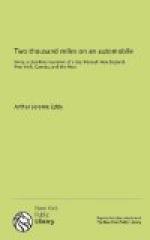One may reach Jackson Park, the old World’s Fair site, by three fine boulevards,—Michigan, broad and straight; Drexel, with its double driveways and banks of flowers, trees, and shrubbery between; Grand, with its three driveways, and so wide one cannot recognize an acquaintance on the far side, cannot even see the policeman frantically motioning to slow down.
It does not matter which route is taken to the Park, the good roads end there. We missed our way, and went eighteen miles to Hammond, over miles of poor pavement and unfinished roads. That was a pull which tried nerves and temper,—to find at the end there was another route which involved but a short distance of poor going. It is all being improved, and soon there will be a good road to Hammond.
Through Indiana from Hammond to Hobart the road is macadamized and in perfect condition; we reached Hobart at half-past nine; no stop was made. At Crocker two pails of water were added to the cooling tank.
At Porter the road was lost for a second time,—exasperating. At Chesterton four gallons of gasoline were taken and a quick run made to Burdick.
The roads are now not so good,—not bad, but just good country roads, some stretches of gravel, but generally clay, with some sand here and there. The country is rolling, but no steep hills.
Up to this time the machine had required no attention, but just beyond Otis, while stopping to inquire the way, we discovered a rusty round nail embedded to the head in the right rear tire. The tire showed no signs of deflation, but on drawing the nail the air followed, showing a puncture. As the nail was scarcely three-quarters of an inch long,—not long enough to go clear through and injure the inner coating on the opposite side,—it was entirely practical to reinsert and run until it worked out. A very fair temporary repair might have been made by first dipping the nail in a tire cement, but the nail was rusty and stuck very well.
An hour later, at La Porte, the nail was still doing good service and no leak could be detected. We wired back to Chicago to have an extra tire sent on ahead.
From Chicago to La Porte, by way of Hobart, the roads are excellent, excepting always the few miles near South Chicago. Keep to the south—even as far south as Valparaiso—rather than to the north, near the lake. The roads are hilly and sandy near the lake.
Beware the so-called road map; it is a snare and a delusion. A road which seems most seductive on the bicycler’s road map may be a sea of sand or a veritable quagmire, but with a fine bicycle path at the side. As you get farther east these cinder paths are protected by law, with heavy fines for driving thereon; it requires no little restraint to plough miles and miles through bottomless mud on a narrow road in the Mohawk valley with a superb three-foot cinder path against your very wheels. The machine of its own accord will climb up now and then; it requires all the vigilance of a law-abiding driver to keep it in the mud, where it is so unwilling to travel.




